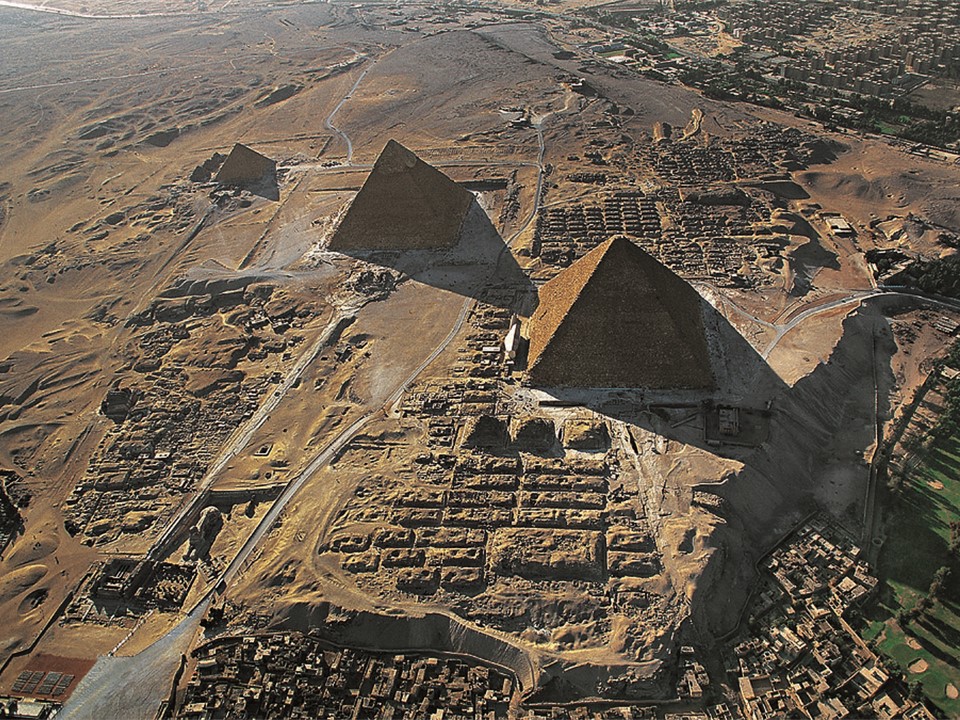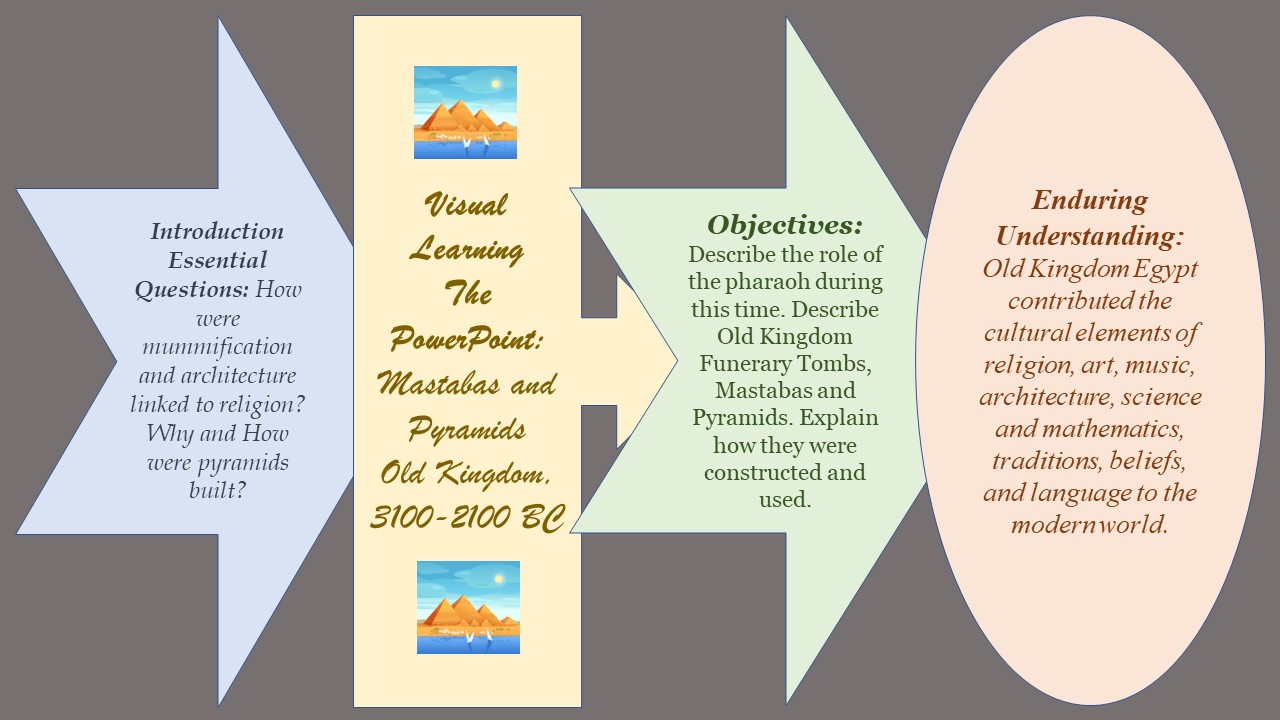
The Pyramid Complex at Giza consists of the three 4th Dynasty pyramids: Khufu (c. 2560 BC), Khafre (2558-2532 BC), and Menkaure (c. 2530-2510 BC), the Sphinx, attendant temples and outbuildings, and the private mastabas of the nobility.
http://giza.fas.harvard.edu/archaeology/
Viewed as a golden age by later Egyptians, the Old Kingdom was a period of great confidence, stability, organization, and administrative control. Exemplified by the soaring pyramids and royal representations that project a remarkable level of poise and serenity, this period demonstrates the stability and wealth that resulted from the success of the storehouse-based economic system. The kings devoted huge resources to provisioning their mortuary cults via state-run building projects. Power was delegated to elite overseers who administered these massive endeavors, earning royal ‘endowments’ for their own afterlife in the process. Labor, both highly-skilled and untrained, was derived from the native population (mostly during the flooding season, when fields could not be worked) and there is archeological evidence that they were fairly compensated… The Architecture of the Old Kingdom Period is interesting to explore! https://smarthistory.org/old-kingdom-first-intermediate-period-introduction/
Let’s start with my Steps to Success Lesson Plan Outline… and continue with the development of ancient Egyptian funerary architecture.

It is important to understand that afterlife was the core of ancient Egyptian religion. In order to achieve life after death, Egyptians believed that the body of the deceased had to be preserved from corruption and damage. The body of the deceased was sacred because it served as the Ka’s eternal sanctuary. It was the duty of those alive to do everything in their power to preserve the body… through mummification and the construction of funerary edifices that will protect the body/mummy and celebrate the deceased memory.
At the very beginning, of the Pre-Dynastic period, Egyptians believed that the souls (Ka) of their deceased Pharaohs were immortal and enjoyed life after death along with their gods. The Ka of the nobles, on the other hand, needed the Pharaoh’s assistance so as to continue its journey to eternity. The Ka of both Pharaohs and nobles needed a well-constructed Tomb to serve as a House of Eternity, and a well-preserved body (mummy) for the Ka to inhabit, whenever needed. It was essential that the memory of the deceased would never be forgotten, and his/her tomb was furnished with all the necessities the Ka needed to live in luxury.
The first step in Egyptian Funerary Architecture is the construction and use of the Mastaba Tomb or Pr-djt, meaning House of Eternity, in Ancient Egyptian. Mastabas are flat-roofed, rectangular-shaped Egyptian structures, with inward sloping sides, constructed out of mudbricks. These edifices marked the burial sites of many eminent Egyptians during Egypt’s Early Dynastic Period and the Old Kingdom. The word Mastaba comes from the Arabic language, and it means stone bench.
The next step in Egyptian funerary architecture is the Pyramid. Nearly all Pyramids were built on the west bank of the river Nile, where, as the site of the setting sun, was, according to Egyptian mythology, the realm of the underworld. Today, archaeologists identify at least 118 Egyptian Pyramids built as part of a funerary complex during the Old and Middle Kingdom periods.
It is believed that the shape of the Pyramid symbolizes the primordial mound from which the Egyptians believed the earth was created, or… the descending rays of the sun. Let’s not forget that the pyramids, finished with polished, highly reflective white limestone, mirrored the sunlight, and served as brilliant beacons of light when viewed from a distance.
The pyramids were, undoubtedly, funerary monuments. Egyptologists, however, are not certain if and how the Pyramids served additional theological beliefs. Could the pyramids serve as a giant ‘magical staircase’ that led the Ka of the deceased Pharaoh directly to the abode of the gods? I like to think so…
The first Pyramid was commissioned by the powerful Pharaoh of the 3rd Dynasty, Djoser. It is the splendid Step Pyramid in Saqqara, designed by the Pharaoh’s vizier/architect Imhotep. Imagine the Pyramid of Djoser as a square mastaba-like structure with six tiers of receding size. During the 4th Dynasty, the transition from Step Pyramid to a true Pyramid shape took place. The great Pyramids of Meidum, Dahshur, and Giza are truly amazing. The Great Pyramid of Khufu, popular since antiquity, was listed by Antipater of Sidon as one of the Seven Wonders of the World. It still is the oldest of the Ancient Wonders and the only one still in existence.
For the Lesson 2 PowerPoint, please… Check HERE!
For a Timeline, please… Check HERE!
Check https://www.youtube.com/watch?v=TMkoX1kfyDs a National Geographic, about 3 minutes, Youtube Video on The Evolution of Ancient Egypt’s Pyramids | Lost Treasures of Egypt
Learn about the characteristics of the Mastaba Tomb of Perneb through a Metropolitan Museum Video… https://www.youtube.com/watch?v=Zou4hzeUOLg
If Netflix is available… Check Secrets of the Saqqara Tomb
Saving Egypt’s Oldest Pyramid by National Geographic Channel, a 48min Video about The Step Pyramid of Djoser in Saqqara… https://www.youtube.com/watch?v=qvSbtf68AOg
A 2022 TED-Ed Video questions… How did they build the Great Pyramid of Giza? … and explores how the ancient Egyptians built the Great Pyramid, a tomb created for Pharaoh Khufu which took over 20 years to complete.